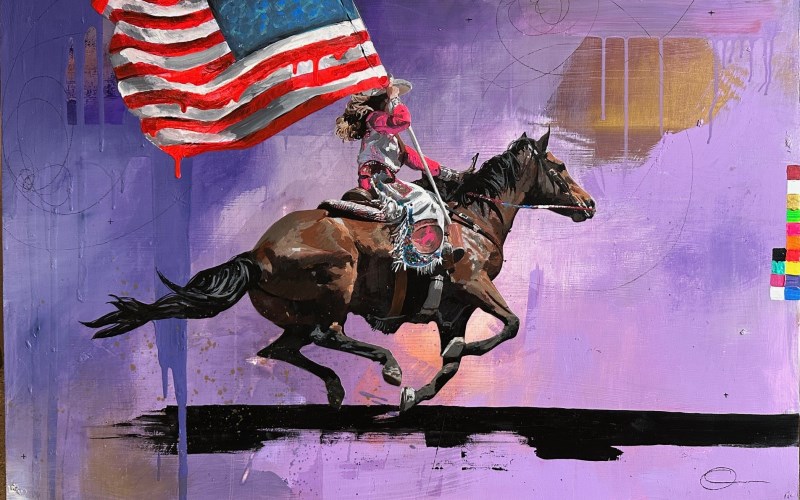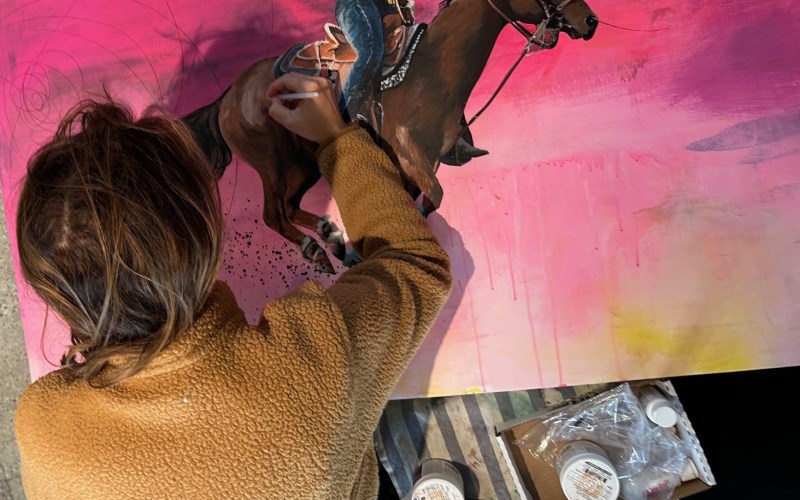|
BY KAREN BOSSICK Charlotte Hemmings thrived under the tutelage of John Blackman, a former Wood River High School art teacher who achieved worldwide recognition for the tiger and eagle he painted on Olympian Picabo Street’s racing helmets. He wrote Hemmings a glowing recommendation for Otis College of Art and Design in Los Angeles, where she earned a BFA in Painting. And, while her art career has wovenits way through acting gigs, she’s back in Ketchum this month with a solo exhibition at Hemmings Gallery, 340 Walnut Ave. Hemmings will be there for Gallery Walk from 5 to 7:30 p.m. tonight—Friday, Dec. 26--when Hemmings Gallery features “Phantom West/Charlotte Hemmings.” The work will be up through Jan. 31.
|
|

Charlotte Hemmings dotes on color and movement.
|
|
|
Her colorful paintings drawn from cowboy and rodeo traditions probe the mythology of the American West. “I’m particularly interested in the over-the-top world of the rodeo,” said Hemmings, who happens to be the sister of gallery owner Edward Hemmings. “Growing up in Idaho but also living far, far beyond it, I’m always kind of circling the tension between where I’m from and where I’ve gone. “I’m not trying to pin down some perfect story of the West,” she added. “I’m more interested in the glow of the West, the pull of the West.” Hemmings has assembled 25 pieces of bucking bronco, bull riders, roping cowboys, barrel racers and rodeo queens.
|
|

Charlotte Hemmings says she occasionally finds herself rooting for the bull and the bucking bronco.
|
|
|
“I’m just finishing a piece depicting wild horses because I love the idea of a horse not being ridden in a rodeo. I also love the idea of a bull winning at least occasionally,” she said. Hemmings was born in Los Angeles—the daughter of actors Prue and David Hemmings, an English actor and director who played in such films as “Camelot,” “Barbarella,” “Islands in the Stream” and “The Charge of the Light Brigade.” “My parents were in the film industry and when I was 7 we were going to move up to Canada because the film industry was moving out of L.A. and things were hopping in Canada. But there was a snafu with the house they were buying. They had a condo out Warm Springs where we spent Christmases so we moved into the condo and never left,” she recounted. “We remodeled it and that’s the house I grew up in.” Young Hemmings attended Hemingway STEAM School and graduated from Wood River High School. There, she came under the spell of art, inspired by Blackman’s teaching.
|
|

Charlotte Hemmings works on a painting of a calf roper.
|
|
|
“He had such a passion for art,” she said. “I was on the Honor Roll and all that, but his art class was a safe place for me to pick out whatever project I wanted to work on. It was the one place in high school where I was self-directed and self-guided. He empowered us that way—always ready to help if we needed it but willing to let us experiment.” Despite her love and passion for art, Hemmings didn’t follow a direct path to amassing a portfolio of work. Having grown up in a family that took part in Laughing Stock Theater and other theater projects, she moved to Los Angeles where she began her career working as a production and art assistant for directors Ridley Scott and Joe Pytka before stepping into the spotlight herself. She’s performed one-woman shows on stage in San Francisco and Off-Broadway in New York, as well as occasional shows in Ketchum, including last October’s “Love Loss and What I Wore” at The Argyros.
|
|

Charlotte Hemmings paints in what she calls her “creative space.”
|
|
|
She has starred in “Beauty and the Billionaire: Bali,” which she describes as a fun murder mystery kind in the vein of a Hallmark movie. She also has appeared in “Stranger in My Home” alongside Sophia Bush, “Dead Girls Trip on Lifetime,” the indie feature “Faith of Angels” and the upcoming horror thriller “The Edge of Normal,” a film directed by Carlota Pereda in which she plays opposite Chloe Grace Moretz. Along the way, she had a bunch of art shows in Los Angeles, and a couple in Sun Valley, including the Starving Art Series and Death to Day Jobs at Ochi Gallery alongside a budding artist named Rudi Broschofsky, who now shows his spray paint on metal work at Broschofsky Galleries in Ketchum. Hemmings continues to express her creativity through both her acting and her art work. She lives in Park City, Utah, where she works out of an acting/painting studio attached to her house. She calls it her “creative space.”
“I’m as passionate about painting as I am about acting. So, when I’m not acting, I’m painting,” she said. For her “Phantom West” works, she laid down what she calls an “incredibly abstract” background—“That’s the fun part.” She transfers hyper-iconic imagery available in the public domain onto the canvas, then dismantles it with gestural marks, drips and swaths of pigment to transform the iconic spectacles of charging horses and flapping flags into a fractured residue of memory and myth. She lets loose with drips before finetuning the details. When she finishes, she covers all with a high-gloss epoxy resin coat. “There’s a lot of movement in these pieces, a lot of performance in them. There’s a cool correlation between my acting and painting and the idea of rodeo and people being bucked around—it’s almost like a dance,” she said.
Hemmings said her interest in rodeos stems back to the Days of the Old West Rodeo at the Hailey arena--a place to see and be seen for most Wood River Valley youth. “I love the rhinestones on the rodeo queens, the tassels and the plaid shirts and the boots and the spurs—it’s so indicative of life in the mountains in the western part of the United States. And I may have stuck in some subliminal messaging in a few of my pieces,” she said. Hemmings said she is grateful to be showing her work in her brother’s gallery. “I’m really excited that he’s given me a show,” she said. “We wanted to do one together for a long time but I didn’t have the body of work and he didn’t really know what I could do. I got commissioned to paint a western cowboy piece for a friend, and my brother saw it and offered me a chance at a show. It’s been eight months of painting like crazy for my solo exhibition so it’s going to be cool.”
|